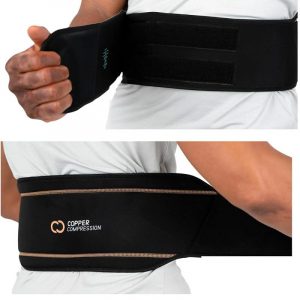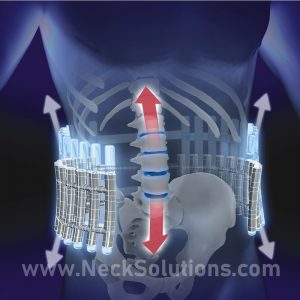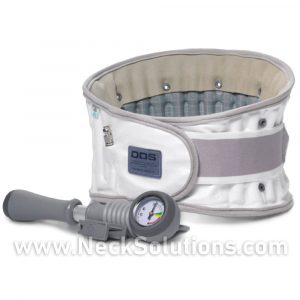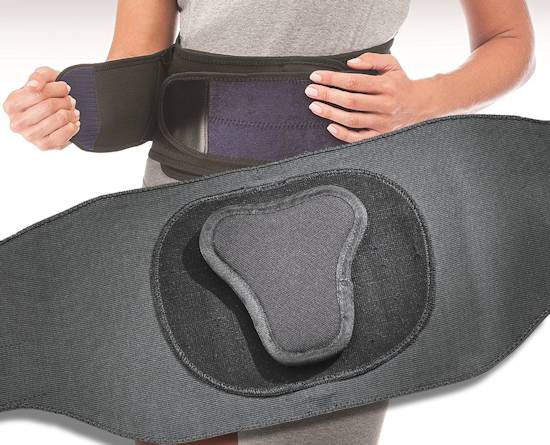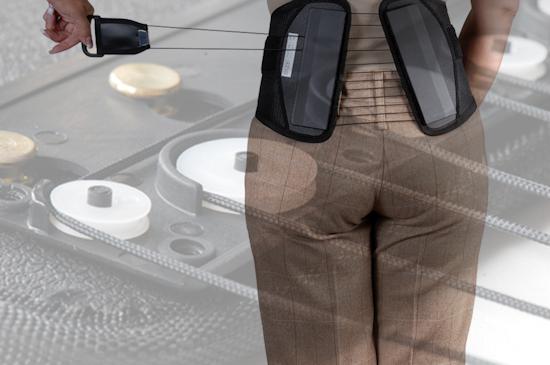Back Support Belts – Benefits & Types Of Supports
Guarding the back using support belts or braces is a good idea for those who have a muscle strain, joint sprain or some other types of injuries or recovery after surgery. If you have back pain and need to keep working or maintain a certain level of activity, back support belts are a great help. Back belts are commonplace in most jobs where heavy lifting is required. We often see people wearing them at work, just because it is recommended, without using any force applied.
We do not recommend using them for show. Support belts are ubiquitous; they come in many styles and designs and range from very cheap ones to high tech belts that are very effective.
When back support belts are designed well, they deliver support that helps prevent and relieve back pain resulting from muscle strain, spasms, sprains and disc problems. For some, this can mean better recovery or be a lifeline to those who need to keep going when your back pain normally prevents daily or work activities.
By constraining action involving muscle groups and suspensory ligaments, back support belts additionally assist in improving good posture as well as serving to prompt one to make use of safe lifting technique.
Elastic Belts
Elastic back support belts are for mild to moderate pain levels and lifting tasks. There are so many types of these braces. How do you know what you can count on to be effective. Many are cumbersome, made of cheap materials and can be either just a cheap wrapping that does nothing or will provide support by sacrificing comfort. While no brace is completely comfortable to wear for long periods, elastic belts are affordable and effective.
Back Belts Using Mechanical Advantage
These braces are made of extraordinarily strong, yet breathable materials that are non-stretch, yet pliable for better compression without giving up comfort. The non-bulky, very low-profile design provides discrete wearability. Comfort and control add up for quicker healing. These belts Maximize a smooth, dynamic approach to abdominal compression, providing stability and control of the spine. Adjusting the belt takes about 1 second, with minimal motion or unwanted body movement. An easy, effortless pull with one hand effectively tightens the belt and you’re ready to go! A 6:1 pull ratio makes them powerful and stable supports.
The mechanical back support belts are used for moderate to severe levels of pain. Those who do heavy lifting at periods throughout the day will benefit from a strong belt. While comfortable to wear for long periods, it is best to use during heavy lifting tasks, or mild lifting task when in a lot of pain. If you have a choice, don’t lift when you are in pain. If you must, this is the belt to use. The belts comes with back and front panels which really enhance stability and maximize compression. These are best to manage inflammation due to the higher compression levels.
Employing this advantage, the Back Brace is a favorite regarding cost and effectiveness. It is a basic member of the family of belts using mechanical advantage for stability and ease of use. It employs a distinctive fastening mechanism as well as supporting system. This is the one I use. It provides superior stabilization and durability and I highly recommend it.
For those familiar with Modic 1 degeneration of the spine and antibiotic therapy, a 2013 article in the German medical journal Deutsches Ärzteblatt International indicates lumbar supports are effective for low grade spinal infections. They recommend 6 – 10 weeks wearing a highly supportive brace in combination with antibiotic therapy. While most cases of spondylodiscitis is treated surgically and aggressively, this recommendation is for cases that can be treated conservatively, where there is no high grade destruction of the spinal bone.
For those who suffer back pain from P. acnes infection who are undergoing therapy with antibiotics, as well as related mechanical Modic degeneration, spinal loading like heavy lifting should be avoided. Wearing a strong, supportive braces with mechanical advantage is highly recommended, should any lifting or stressful activity be necessary.
Benefits Of Wearing Support Belts
The advantages effect components of back pain, like restriction of motion to help confine the disc, joints and muscles. Bending forward may increase disc pressure, while bending back may irritate facet joints. Conditions involving both of these structures can result in back pain with pain radiating into the lower limb. Increasing abdominal pressure without strain, as the bracing helps to minimize disc compression and allows daily and work activities with less force on sensitive structures. Support belts can also effect posture control with an educative outcome from maintaining the spinal column within normal limits. Helping to stabilize the spine can create better posture, with mechanical belts actually restricting postures that can harm the spine.
 During the acute stage of an injury, rest and ice/cold applications are usually recommended for the first few days depending on the extent of injury. The goal is to reduce inflammation and further damage. Using a support offers the impaired tissues the ability to recover without having additional damage. Compression helps with managing and also minimizing inflammation. As your condition progresses, belts can help manage initial stages of activity through healing with greater levels of motion and warmth for increased circulation.
During the acute stage of an injury, rest and ice/cold applications are usually recommended for the first few days depending on the extent of injury. The goal is to reduce inflammation and further damage. Using a support offers the impaired tissues the ability to recover without having additional damage. Compression helps with managing and also minimizing inflammation. As your condition progresses, belts can help manage initial stages of activity through healing with greater levels of motion and warmth for increased circulation.
Braces are often used with chronic pain, especially overuse injuries where the tissues do not receive sufficient rest periods for healing and are frequently re-injured. Optimum stabilization using a mechanical or elastic support can help under situations where rest and restorative therapy are either insufficient or not possible. Stability is a feature which supplies added support to weakened tissues. For instance, a lower back muscle strain can lead to weakness of the suspensory ligaments which support the spine and pelvis. Appropriate back support belts which have a higher amount of ergonomic force can help the weakened ligaments capability to stabilize.
The primary principle of back support belts is stabilization of joints, however, muscle receptors are also stimulated. The materials ensure controlled compression with panel inserts and massage provided by pads that are integrated into the support helps with inflammation. There can be multiple functions in using a support; relief, stabilization, immobilization, mobilization, and correction. The back can be immobilized and may be mobilized with motion in a controlled manner. It is possible to use them to for posture correction as well.
Scientific Evidence For Using Back Braces
- A 2014 study in the journal Spine showed that a more stronger back belt that adds to motion restriction and trunk stiffness produced better results in disability scores than a more elastic type of brace as well as standard care for lower back pain.
- A 2015 study in the Spine Journal showed that lumbar spine function does not worsen when using a mechanical advantage type belt continuously for 2 weeks for those both with and without back pain.
- In BMC Medicine Journal, 2012 February 29; research established that for particular radiographic results from the degenerative disc disease process, using back belts as much as four hrs per day in addition to rest was in fact as good as exercising with regard to chronic lower back pain.
- An additional report inside the Fukushima Journal of Medical Science. March, 2012 established that utilizing belts with regard to chronic back pain enhanced lower back pain relief as well as improved muscular endurance with regard to a limited time period. Low back muscular weakness had not been elevated through extended use regarding back belts and deterioration of back muscle groups had not been experienced approximately six months following the beginning of using belts.
- The November, 2014 issue of the Fukushima Journal of Medical Science featured a study in which the authors followed 144 individuals with back pain to see the effects of a wearing a lumbosacral back belt for 3 months. They found that the number of days with pain as well as lower back pain intensity decreased significantly. They noted that wearing the support for 3 months did not negatively effect the muscles and a support that tightly supports the lower back is effective for reducing mild low back pain as well as increased walking efficiency.
- A 2015 study in the journal PLoS One indicated that a belt can improve health related quality of life, improve postural steadiness and decrease sacroiliac joint related pain. The authors state that sacroiliac belts are considered both cost effective and a low risk treatment of sacroiliac joint pain.
- A 2002 study in the journal Occupational Medicine (London) provides some clues on who will benefit from support belts. 70% of home care workers with low back pain reported they perceived benefit from wearing a support. Compliance was high. The more the workers perceived benefits of reducing pain, the better the results. Higher compliance with using the belt was seen in those that considered they can influence their own health. One of the reasons we have selected our braces is for confidence in the product; they are not your typical drug store or cheap imported supports. Wearing a brace can have a positive influence on outcomes which are greatly influenced by patient beliefs.
- A multi-center, clinical 2009 study in the journal Spine found an elastic lumbar belt significantly improved pain level, functional status, and pain medication use in patients with low back pain.
- A 2018 study in the Journal of Orthopaedic & Sports Physical Therapy showed an over 87% agreement rating for those suspected with lumbar instability in getting relief with use of a back brace or corset.
- A 2020 study in Cureus examined back pain from weight lifting in young adults. Significant injuries were noted mainly to the lower two lumbar levels with localized and radiating pain. The authors noted, “Factors that helped relieve the pain included surgery, swimming, and wearing a back brace.”
Do Back Support Belts Cause Muscle Weakness?
There are many health care professionals who may indicate that back braces cause muscle weakness and therefore should not be worn. However, the literature does not support this opinion.
- A 2017 review in the Spine Journal found no conclusive scientific evidence to indicate support belts result in weakness of trunk muscles. Another 2017 review in the Spine Journal found no negative effects with continuous use of back belts for 1 to 6 months.
- Wearing a back belt as a protective device can be beneficial when lifting. Wearing a simple elastic type belt should be for reinforcing proper lifting habits. A July, 2014 Journal of the Medical Association of Thailand showed that a back belt used when lifting enhances rectus abdominis muscle activity, preventing weakness of the transversus abdominis muscle and improving abdominal pressure.
- A 2002 study in the Journal of Orthopaedic Science found a back belt reduced loading of the trunk muscles and that the strength of the back muscles and abdominal muscles actually increased. Similarly, an earlier 1992 study of construction workers with back pain in the Journal of Spinal Disorders found that after 2 months of wearing a back belt, trunk flexor muscle endurance as well as strength increased by 29%.
- A 2019 study in the journal PLoS One evaluated elastic lumbar support belts effects on use for acute lumbar back pain and concerns of muscle deconditioning due to passive stabilization.
The authors found the belt produced a reduction of abdominal amplitude levels from the stabilization which elevated intra-abdominal pressure thus enhancing spinal stability. This offered well coordinated action of the trunk muscles to improve stability. The belt, with its movement restricting effect, activates the paravertebral musculature. The results indicate the effect of elastic belts is a temporary neutral alteration of trunk muscle coordination and not uniform deconditioning.
They noted a significant improvement of functional impairment in acute back pain by wearing the elastic lumbar support belt. Interestingly, the belt use displayed reduced pain and activity related effect of use during walking, where the spine is better stabilized.
Doctor’s Note On Back Support Belts
Experience indicates that patients tend feel more stable and safer during physical activity when wearing belts. Self reported surveys do indicate that in those with lower back pain, wearing a belt permits continuation of activities with less discomfort. Good supports can help patients take control of their condition and foster responsibility and self-awareness.
I do not like wearing back support belts continuously all day at work if you do not experience back problems. Most workers will just wear them loosely where they can interfere with activities. Wearing them compressed all day without problems may lead to problems by altering biomechanics. The problem can come when the braces are not used. One of the techniques I use myself when using the mechanical advantage belt, is to slowly release the pressure. It is simple enough with the pulley system to release the pressure for a few minutes, then repeat a few times before removing.
Determining if a particular support is appropriate and if you have the capacity to benefit from it’s functionality to the fullest is multifactoral; your particular condition, fitness level, activity level, and a complete examination by health care professional(s) are crucial.
- A 2019 study in the journal PLoS One provides mechanisms of influence regarding lumbar belts. Although limited, the results are insightful and provide further areas of study in understanding parameters in specific patient application.
The effect is to influence a positive bending moment within the frontal axis, and this causes a reduction of the lumbar lordosis or curve. This result is a decrease in pressure on back part of the disc, while increase in the front. This can have a therapeutic effect in decompressing anatomical structures in order to reduce strain and pain. Thus, the intended effect is a higher bending moment with resultant lower pressure.
As indicated in a 2021 Journal of Biomechanical Engineeringcompression can result in damage to disc endplates, nucleus pulposus, and the outer annulus fibrosus, which can lead to disc degeneration. Belts should be used with any disc injury that requires any type of lifting and other sources of compression as well as poor posture to decrease compressive forces.
The belt design, materials, adherence, spinal condition and body shape all play a role in the mechanical effects. The reduction of the back curve depends on BMI and for patients who are obese and have an exaggerated curve or hyperlordosis, a belt can increase the lordosis angle and be counterproductive. Having a strong mechanism and size variations can help minimize this effect and should be taken into consideration. In other words, the higher the BMI, the more a typical belt either does nothing or does harm.
In healthy weight patients, the therapeutic forces of pressure are from front to back, having a maximum pressure on the front.Whereas higher BMI patients have the pressure spread around the trunk, compressing mainly fat tissues.
In addition to a strong compression method and sizing variation, the adhesion of the belt greatly influences the pressure. Slippage not only minimizes compression, but allows an asymmetrical application that reduces correct pressure application. Therefore, avoid slippery materials and make sure that the belt is applied evenly. This means for one sided pull braces, the method of closure and tightening should be done carefully to maximize symmetrical application. Failure to do so may result in almost two and a half times more pressure on one side compared to the other. This may be extrapolated to accommodate antalgic or scoliotic postures.
Other factors like belt material in relation to skin pressure and condition, and things like humidity play a role as well. Finding a reasonable balance can lead to better selection and application of back support belts.
- A 2019 study in Clinical Biomechanics found wearing soft lumbosacral belt at normal pressure, high pressure and no belt groups for 4 weeks, in addition to medication. Pain improved in all groups, however disability and proprioception improved in the high pressure and normal pressure groups. The improvements in pain and proprioception were significantly greater in the high pressure group than the normal pressure group. The authors concluded long term use had no significant adverse effects in patients with chronic low back pain and increasing tightness may improve motor functioning and the clinical efficacy.





